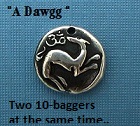U.S. Economy Warms Up After Winter's Chill 05/1
Post# of 63899

U.S. Economy Warms Up After Winter's Chill
05/17/2016 | 01:28pm EDT

By Ben Leubsdorf
The U.S. economy is stabilizing after another rough winter, shrugging off worries about a recession or prolonged slowdown.
Economic gauges released Tuesday showed a pickup in industrial output, continued momentum in the housing sector and firming inflation all pointing to stronger -- though still unspectacular -- growth in the second quarter. That joined other recent data showing a rebound in retail sales, rising consumer confidence and continued job gains.
"We've gotten confirmation that the fears of recession or deflation...that we saw earlier this year have been dispelled," said economist Diane Swonk, founder of consultancy DS Economics.
Federal Reserve officials, wary of volatility in financial markets and weakness overseas, have held short-term interest rates steady this year after raising them in December from near zero. A second-quarter rebound for domestic growth and rising inflation, if sustained, could help push officials to raise rates in the coming months. Policy meetings are scheduled for mid-June, late July and mid-September.
"I think that the data to my mind are lining up to make a good case for rate increases in the next few meetings, not just June, which means it's very live in terms of that," San Francisco Fed President John Williams told The Wall Street Journal on Tuesday.
Gross domestic product, the broadest measure of goods and services produced across the U.S. economy, expanded at a 0.5% annual rate in the first three months of 2016. But growth appears poised to accelerate. Forecasting firm Macroeconomic Advisers on Tuesday estimated GDP would expand at a 2.3% pace in the current quarter. The Federal Reserve Bank of Atlanta put its estimate for second-quarter growth at 2.5% after Tuesday's data.
Ms. Swonk said she expected 2.5% growth, calling it "nothing to write home about, but a nice snapback."
Since the recession ended, first-quarter GDP growth has consistently come in weak, followed by a stronger second quarter. This year may have been no exception, and Tuesday's reports reinforced the picture of resumed modest growth in the overall economy.
The Fed said industrial production -- a measure of everything made by factories, utilities and mines -- surged 0.7% in April, the biggest jump for a single month since November 2014.
Utilities drove the increase, boosting output by nearly 6% to respond to higher demand for electricity and natural gas. The Fed attributed the jump to a return to normal weather in April after a warmer-than-usual March.
Factory output grew 0.3% in April after falling by the same pace in March. Demand for big-ticket items like machinery and cars picked up last month.
Manufacturing production as measured by the Fed has been flat so far this year, a sign that the factory sector remains weakened after more than a year of pressure from falling oil prices and a strong dollar. But the situation is no longer deteriorating. A closely watched gauge of industrial sentiment, published by the Institute for Supply Management, signaled expansion the past two months for the first time since last summer.
The housing recovery has been a steady contributor to broader economic growth over the past two years. In the first quarter, residential investment added 0.49 percentage point to the quarter's 0.5% growth rate for GDP, according to Commerce Department data.
Home building has appeared to remain on track into the spring. Housing starts rose 6.6% in April from a month earlier, the agency said Tuesday, and building permits climbed 3.6% from March. Over the first four months of 2016, starts rose 10.2% compared with a year earlier and permits were up 2.9%.
Long-sluggish U.S. inflation appears to be firming as the labor market tightens, oil prices rise and the dollar weakens. The consumer-price index, which measures what Americans pay for everything from fresh fruit to footwear, increased a seasonally adjusted 0.4% in April from the prior month after rising 0.1% in March, the Labor Department said Tuesday. That was the largest one-month increase since February 2013.
Rising prices at the pump drove last month's jump, with gasoline prices up a seasonally adjusted 8.1% from March. (Gas prices typically rise through the spring and peak in the summer months.) The national average price for a gallon of regular gas on Tuesday was $2.23, up 11 cents from a month earlier, according to auto association AAA. Still, the national average price was down 48 cents over the past year.
A measure of underlying price pressures, which excludes the often-volatile categories of food and energy, rose 0.2% last month after ticking up 0.1% in March, the Labor Department said. Core prices were up 2.1% from a year earlier, a fifth consecutive month of annual growth above 2% -- the longest such streak in four years.
Inflation has undershot the Fed's 2% annual target since 2012. The central bank prefers to use an alternative measure, t he Commerce Department's personal consumption expenditures price index, which rose 0.8% in March from a year earlier and climbed 1.6% excluding food and energy prices.
"We view this rise in inflation as consistent with our view that reduced slack in the U.S. economy will continue to put upward pressure on prices, " said Michael Gapen, chief U.S. economist at Barclays.
Even with data coming in stronger, many forecasters remain cautious about the overall economy's health. Business and academic economists surveyed by the Journal this month estimated the U.S. faces a 20% chance of tipping into recession in the next year, down only a bit from a few months earlier.
 (0)
(0) (0)
(0)